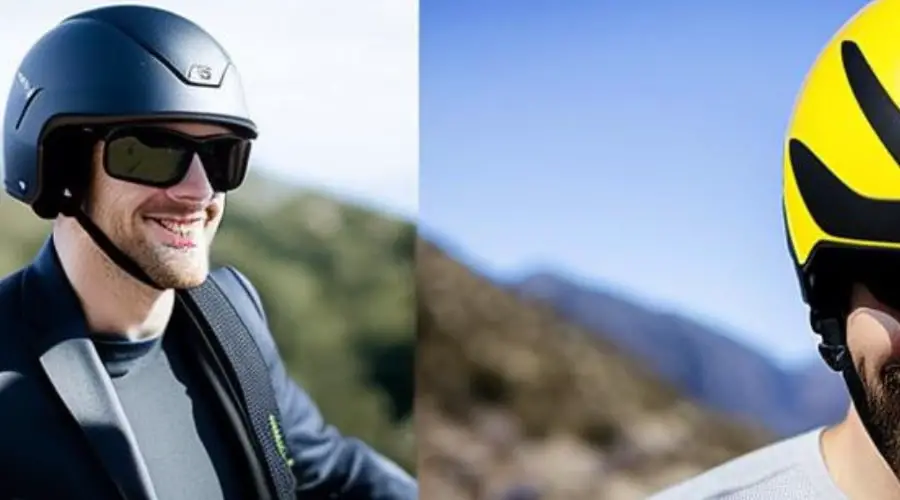As motorcycle enthusiasts, we know the importance of wearing a helmet while riding. Not only is it required by law in most states, but it also protects our most valuable asset – our head. However, with so many different types and styles of helmets on the market, it can be overwhelming to choose the right one. In this article, we will discuss the various types of helmets and their features to help you decide which helmet is good for men.
Full-Face Helmet
The full-face helmet provides the most protection out of all the helmet types. It covers the entire head, including the face, and has a chin guard that protects the lower face and jaw. This type of helmet is suitable for high-speed riding and offers the most protection against impacts and weather elements.
Open-Face Helmet
The open-face helmet covers the top of the head and the back but leaves the face exposed. It does not have a chin guard and offers less protection than a full-face helmet. This type of helmet is suitable for low-speed cruising and warm-weather riding.
Modular Helmet
The modular helmet combines the features of a full-face and open-face helmet. It has a chin guard that can be lifted, converting it into an open-face helmet. This type of helmet offers versatility and is suitable for both high-speed and low-speed riding.
Half Helmet
The half helmet is the smallest and lightest helmet type. It covers only the top of the head and does not provide any protection for the face or jaw. This type of helmet is suitable for low-speed cruising and warm-weather riding.
Dual-Sport Helmet
The dual-sport helmet is designed for off-road and adventure riding. It provides the most ventilation and features a visor to protect the rider from dirt and debris. This type of helmet is suitable for both on-road and off-road riding.

Features to Consider
- Safety ratings
- Fit and comfort
- Ventilation
- Visor and shield
- Noise reduction
- Weight
Safety Ratings
When choosing a helmet, it is essential to consider its safety rating. The Department of Transportation (DOT) and the Snell Memorial Foundation are the two primary organizations that test and rate helmets’ safety. Look for helmets that have either DOT or Snell certification.
Fit and Comfort
A helmet should fit snugly but not be too tight. It should sit low on the forehead and cover the back of the head. Make sure to try on helmets before purchasing them to ensure a proper fit. The helmet should also be comfortable to wear for long periods.
Ventilation
A well-ventilated helmet will keep the rider cool and comfortable. Look for helmets with multiple vents and exhaust ports to allow for maximum airflow.
Visor and Shield
The visor or shield should be clear and scratch-resistant. It should also be easy to operate with gloves on. Some helmets come with a built-in sun visor, which is a useful feature for bright days.
Noise Reduction
Helmets can be noisy, especially at high speeds. Look for helmets with noise-reducing features, such as padding and acoustic liners.
Weight
A heavy helmet can cause neck strain and fatigue. Look for helmets that are lightweight and balanced.
FAQs:
What is the most protective helmet type?
The full-face helmet is the most protective helmet type as it covers the entire head and has a chin guard that protects the lower face and jaw.
What is the most comfortable helmet type?
The most comfortable helmet type is subjective and depends on personal preferences. However, helmets with good ventilation, a proper fit, and lightweight are generally considered more comfortable.
Can I use a half helmet on the highway?
While half helmets are legal on the highway, they offer minimal protection and are not recommended for high-speed riding.
What are the best helmet brands?
Some of the best helmet brands include Shoei, Arai, Bell, HJC, and AGV.
How often should I replace my helmet?
Helmets should be replaced every five years, or sooner if they have been involved in an accident or sustained damage. It is important to inspect the helmet regularly and replace it if it shows any signs of wear and tear.
Conclusion
Choosing the right helmet is crucial for every rider’s safety and comfort. Consider the type of riding you will be doing, the helmet’s safety ratings, fit and comfort, ventilation, visor and shield, noise reduction, and weight. With this guide, you will be able to find the perfect helmet that suits your needs and provides you with the best protection.
Helmetslab is a website that focuses on providing in-depth reviews and information about different types of helmets, including motorcycle helmets and others helmets. I am writing a post with proper research on the info that helps helmet users.

